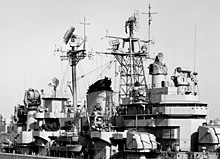AN/SPS-8
 AN/SPS-8B aboard a USS Providence | |
| Country of origin | United States |
|---|---|
| Manufacturer | General Electric |
| Introduced | 1952 |
| Type | 2D |
| Frequency | S Band |
| PRF | 1000 Hz |
| Beamwidth | 3.5° |
| Pulsewidth | 2 µs |
| Range | 111 km (60 nmi) |
| Power | 650 kW |
AN/SPS-8 is a manufactured by General Electric. It was used by the US Navy as a height finding radar after World War II, and was equipped aboard naval ships during the Cold War. Variants include AN/SPS-8A, AN-SPS/8B, AN/SPS-8C and AN/SPS-8D After modernization, it was redesignated as AN/SPS-30.[1]
AN/SPS-8[]
It worked in two modes in terms of range - with a pulse frequency of 1000 Hz (pulse duration 1 μs, range 154 km) and 500 Hz (2 μs, 308 km). In a real situation, the F2H aircraft was detected at a distance of 111 km (SPS-8A / B modifications - 133 km).
The target elevation angle was determined by scanning the beam in the vertical plane with a frequency of 5, 10 or 20 Hz (in the SPS-8B modification -6, 12 and 16.5 Hz). The accuracy of determining the height was 150 m. The deflection of the beam in elevation was carried out by a feed in modifications SPS-8 and SPS-8A and an organ-type feed in modification SPS-8B
In the SPS-8A modification, the capacity was increased from 650 kW to 1 MW with a design capacity of 2 MW. In the 2-μs pulse mode, pulse repetition rates of 450 and 750 Hz were provided.
The SPS-8 and SPS-8A used the same mesh antennas. SPS-8B, first tested in January–June 1956 and put into service in 1959, had a high gain antenna (41 instead of 37.4 dB), a narrower beam (1.2 ° × 1.5 °) wider scanning sector in elevation (12 °) at a vertical scanning frequency of 6, 12 and 16.5 Hz.
The information was displayed on the VK circular view indicator (Model VK Plan Position Indicator) and the VL range-height indicator (Model VL Range-Height Indicator).

Onboard ships[]
 United States[]
United States[]
- Essex-class aircraft carrier
- Midway-class aircraft carrier
 AN/SPS-8A aboard USS Canberra
AN/SPS-8A aboard USS Canberra - Forrestal-class aircraft carrier
- Independence-class aircraft carrier
- Iowa-class battleship
- Baltimore-class cruiser
- Worcester-class cruiser
- Boston-class cruiser
- Providence-class cruiser
- Galveston-class cruiser
- Mitscher-class destroyer
- Gearing-class destroyer
- Guardian-class radar picket ship[2]
 Canada[]
Canada[]
AN/SPS-30[]
Based on the SPS-8B, the best American sweeping beam radar, the SPS-30, was created, which used a high gain antenna and a 2.5 MW klystron. Work on its creation began in 1956. It is a three-dimensional radar.
It was planned to upgrade the SPS-8 and SPS-8A to SPS-8C / D with the installation of the same antennas and klystrons as on the SPS-30, but these plans were not implemented, although at the end of 1957, 30 new antennas were produced.
A modification of the SPS-8 was the CXRX radar,

Onboard ships[]
 United States[]
United States[]
- Essex-class aircraft carrier
- Boston-class cruiser
- USS Atlanta
- Galveston-class cruiser
- Gearing-class destroyer
 Canada[]
Canada[]
See More[]
| Wikimedia Commons has media related to AN/SPS-8. |
- List of radars
- Radar configurations and types
- Height finding radar
Citations[]
- ^ "AN/SPS-8 - Radartutorial". www.radartutorial.eu. Retrieved 2021-06-16.
- ^ "US Navy Radar Picket Ships". www.radomes.org. Archived from the original on 2002-08-04. Retrieved 2021-06-16.
References[]
- Norman Friedman (2006). The Naval Institute Guide to World Naval Weapon Systems. Naval Institute Press. ISBN 9781557502629
- Self-Defense Force Equipment Yearbook 2006-2007. Asaun News Agency. ISBN 4-7509-1027-9
- Naval radars
- Military radars of the United States
- Military equipment introduced in the 1950s
